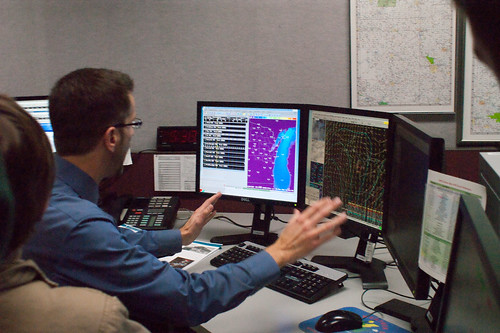面對氣候變遷,美國白宮、聯邦機構和部分民營企業19日宣布啟動「氣候資料計畫」(Climate Data Initiative),提供氣候相關政府資料,幫助全美各地建構應變彈性,對抗逐漸讓美國人民難耐的高溫。
這項計畫也正式啟用climate.data.gov平台,此網站是美國政府資料開放平台(Data.gov)的氣候變遷專章,由國家海洋和大氣管理局(NOAA)與太空總署(NASA)主持,美國總務署管理,除了讓聯邦的氣候資料更公開透明,也提供給公民、研究者、企業家和發明家運用。
氣候變遷世代 民眾、企業都須了解、因應
白宮聲明稿寫道,氣候資料計畫鼓勵民間企業運用聯邦政府大量、公開的氣候相關資料,進一步開發創新技術,以支援國家的氣候變遷因應對策。
這項計畫實踐了歐巴馬去年6月的「氣候行動計畫」(Climate Action Plan)承諾,以資料庫串連區域城市的規劃者、資源經理、農民、醫院和企業界,協助他們深入了解氣候變遷的潛在衝擊,並事先規劃準備;資料庫的開放也提供全美民眾面對氣候變遷所需的相關資訊,讓地方社群了解如何自保,並防範氣候變遷未來可能產生的衝擊。
海平面上升、基礎設施等資料已公開
氣候資料計畫初期將著重在海平面上升和沿海洪災的資料和分析工具。例如預測海平面上升的地圖,能做為建商規劃建案位置的參考。其他還有能幫助水公司辨識出潛在水源供給問題的線上工具。
同時NOAA和NASA也舉辦創新競賽,鼓勵企業家、技術人員和開發人員設計開發資料視覺化和模擬器工具,以助大眾了解海岸侵蝕以及其他氣候變遷帶來的危險。
美國地質調查局、國土安全部、國防部和國家地理空間情報局也發表地理資料庫,內有數10萬個基礎設施的地圖資料,涵蓋橋樑、道路、鐵路隧道、運河和水位表。
Google、微軟、Esri推廣 地圖、app都可用
不過釋出資料和讓人取得是兩回事。NOAA每天蒐集20 TB的資料,其中大部份資料難以讓民眾取用。NOAA正尋求產業界、非政府組職、研究單位、大學和私人企業協助,讓資料庫能快速且大規模地讓民眾取用。
Google已經承諾將提供1PB(1000TB)的雲端儲存空間,存放衛星觀測資料、數位高度資料、來自政府和科學界的氣候與氣象模型資料庫,還會贊助Google地球引擎地理空間分析平台的5千萬小時高效能雲端運算。
英特爾、微軟和地理資訊系統技術巨擘──美國環境系統研究所公司(Esri),也將開發地圖、手機app等工具和程式,協助地方官員和利害關係人士瞭解氣候對當地社區的風險。
The White House, federal agencies and private partners Wednesday unveiled the Climate Data Initiative, a project that gives local leaders across the country information to plan for the impacts of climate change while building resilience to rising temperatures already affecting Americans.
The Climate Data Initiative makes use of the federal government’s extensive, freely-available climate-relevant data resources to stimulate innovation and private-sector entrepreneurship in support of national climate-change preparedness, the White House said in a statement.
The Climate Data Initiative also fulfills a promise in Obama’s Climate Action Plan announced last June – ensuring that communities across America have access to the information and tools they need to protect themselves from harm today and potential damage in the future.
This means connecting regional and city planners, resource managers, farmers, hospitals, and businesses with data-driven tools to help them better understand, manage, and prepare for the real-world impacts associated with climate change.
With leadership from the National Oceanic and Atmospheric Administration, NOAA, and the National Aeronautics and Space Administration, NASA, the administration is launching climate.data.gov.
This new climate-focused section of Data.gov, the federal government’s open data platform hosted by the General Services Administration, will make federal data about the climate more open, accessible, and useful to citizens, researchers, entrepreneurs, and innovators.
First, the initiative will focus on providing data and tools related to sea-level rise and coastal flooding. For instance, maps of future sea-level rise can help builders decide where to break ground out of harm’s way. Other online tools can help water utility operators identify potential threats to the local water supply.
NOAA and NASA are launching an innovation challenge to encourage entrepreneurs, technologists, and developers to create and deploy data-driven visualizations and simulations that help people understand their exposure to coastal-inundation hazards and other vulnerabilities.
The U.S. Geological Survey, U.S. Department of Homeland Security, U.S. Department of Defense, and National Geospatial-Intelligence Agency are releasing a collection of datasets containing mapping information about hundreds of thousands of the nation’s infrastructure units and geographical features, including bridges, roads, railroad tunnels, canals, and river gauges.
But it’s one things to release data and another to make it easy to access. Of the 20 terabytes of data NOAA gathers every day, only a small percentage is easily accessible to the public.
NOAA now is seeking input from industry, nonprofits, research laboratories, universities, and private-sector partners on ways to make all this data available to the public in a rapid, scalable manner.
Google is committing to provide one petabyte (1,000 terabytes) of cloud storage to house satellite observations, digital elevation data, and climate and weather model datasets drawn from government and contributed by scientists as well as 50 million hours of high performance cloud computing on the Google Earth Engine geospatial analysis platform.
Intel, Microsoft, and Esri will create maps, apps, and other tools and programs to help local officials and other stakeholders understand the climate risks specific to their communities.
※ 全文及圖片詳見:ENS








